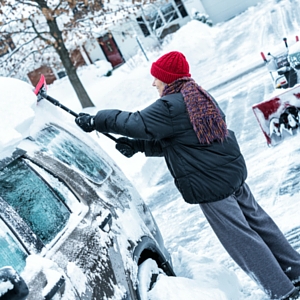Is Your Car Ready for Harsh Winter Weather?

When you heard the first major storm of winter was on its way, you pulled out your cold weather clothes, stocked the pantry and found the snow shovel. You are ready—but is your car?
Keep Things Fluid
Before the bad weather hits, pop the hood and check your battery, belts and hoses, antifreeze and windshield washer. Here's what to look for:
- Battery – Batteries lose power in cold temperatures. Before it gets too cold outside, check the battery terminals for signs of any corrosion, make sure the connectors fit tightly and that there are no cracks in the cables. In addition, check the voltage. A full charge is 12.6 to 12.8 volts and a half charge is 12.2-12.4 volts. If it's below that, you may want to replace your battery, particularly if it's 3-5 years old.
- Antifreeze - Did you know that the antifreeze in your car is actually a mix of antifreeze and water? Check your antifreeze level, and if it's low, add antifreeze that contains ethylene glycol.
- Engine Oil – In warmer weather, engine oil with high viscosity (meaning it's thicker) is fine, but in winter, thinner oil is better. You may want to consider 10W-40 in the summer and 5W-30 in the winter. Check the recommendations of your car’s manufacturer.
- Windshield Washer Fluid – Fill your windshield washer reservoir with a washer fluid that contains de-icing fluid instead of water. You'll find it will be helpful for removing frost from your windshield.
- Gas – In cold weather, condensation (water) can form on the walls of your gas tank, and water in your gas tank can cause your fuel line to freeze. So keep your car filled up to avoid freezing it up!
Get a Grip!
Two more places to check on your car are the areas where the rubber meets the road—and the windshield. Whether it's raining or snowing, it's important that your tires and windshield wiper blades are in good condition.
- Tires - Most cars have all-season tires, which are meant to get you through most types of weather. Make sure your tires are in good condition with no bulges or bald spots, and that they are properly inflated.
- Windshield Wiper Blades – Just like tires, windshield wiper blades in good condition are essential for safe driving in winter weather. However, if your wiper blades do not grip the windshield or are splitting, they won't do you any good.
See Things Clearly
Your vision might be 20/20, but if your lights and windshield are damaged or obstructed, you might have trouble seeing outside of your car in bad weather.
- Lights – If your headlights look foggy, they may be "etched." Remove the etching to ensure you can see properly in less-than-ideal driving conditions. In addition, be sure to remove any snow that has covered your headlights and tail lights so you can see the road and other cars, and they can see you.
- Windshield – If you find a chip in your windshield, get it fixed before the temperature falls below freezing. If you don't, the chip could turn into a crack, and the bigger the crack is, the more dangerous it is. Since most insurance companies will pay for chip repair if you buy the coverage, and most glass companies will come to your home or business, there's no reason not to get it fixed.
On the Inside
Stock your car with the following supplies to be prepared if you do get stuck.
- A small shovel
- An ice scraper
- Sand, salt or kitty litter for traction
- Boots, extra gloves and a blanket
- Flares and matches or orange caution triangles so others can find you
- Jumper cables
- A flashlight
- Non-perishable food items
- Hard candies to keep your mouth from drying
- And keep your cell phone with you while driving
Although it's best to avoid driving in bad weather, that's not always an option. If you do have to go out, choose the safest routes. And if you do get stuck, you will be ready if you prepared your car for winter's harsh conditions.
